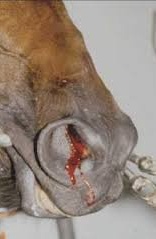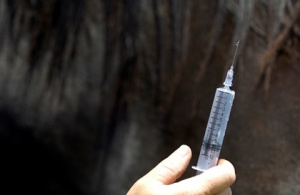According to a study published on Friday, 25 July 2014, researchers from the Maxwell H. Gluck Equine Research Centre found horses based in Hong Kong that experience exercise induced pulmonary hemorrhaging (EIPH) raced just as long as their non-bleeding contemporaries without the addition of furosemide, commonly known as Lasix. These findings resulted from one of the first reports using epidemiologic analysis of longitudinal data regarding the Thoroughbred racehorse.
Dr. Stephanie A. Preston, MS, PhD, of the Equine Soundness and Sports Medicine Program of the Maxwell H. Gluck Equine Research Center at the University of Kentucky and one of the paper’s co-authors said, “The first thing that is very important is the epidemiologic analysis of longitudinal data. The longitudinal component means that we are analyzing data throughout the career of the horse. We don’t have access to that kind of information in the United States which is why I went to Hong Kong.”
She said, “What I think is most important over all about this finding is that the health status of a Thoroughbred racehorse is not a static moment in time. It can’t be measured as such. You can’t simply scope a horse one time and grade its severity and be certain and have any confidence whatsoever after reading my paper, that the result is actually a good reflection of the horse’s disease status over time. It’s a very good example of why we need to look at research more closely.”
A member of the industry for 25 years prior to obtaining her PhD, Preston noted that her experiences as a jockey and as a manager of her family’s racing stable were vital in her approach to this research. “I have always been a die-hard medication person,” Preston continued. “Every single horse that we ran, they raced on Lasix. Why I went back to get a PhD in the first place is that I am very passionate about issues that are related to welfare and racing. Obviously that’s become a very important topic for all of us these past few years.” Preston added, “It’s important to have data and scientific evidence to form our opinion and certainly to form our policies.”
Preston’s approach was specifically centered on using racehorses that were actually still racing, so the results could be as applicable to the Lasix question as possible. “It is very important to the industry because it’s based on real-life horses,” Preston remarked. “What prompted me to do this study is I’m actually very interested in lameness and the number of injuries that we see in Thoroughbreds and what’s causing that. Why constantly every year, are we seeing fewer and fewer starts for the American horses when the rest of the world is not having that problem?”
Armed with the Hong Kong Jockey Club data from her original lameness study, Preston turned her attention to one of the major differences between U.S. racing and the majority of the rest of the world – Lasix use. Preston set out to discover what happens when you don’t run on Lasix. An overarching theme with the Hong Kong Jockey Club is the idea of total transparency, so that the bettor may participate with maximum confidence. Hong Kong does not breed their own horses, so all data collected was from active racehorses in training. For the purposes of increasing uniformity, all of the data was collected from 822 imported New Zealand-bred geldings of the 836 total horses imported from that country between 2007-2012.
“For a lot of different reasons, the Hong Kong Jockey Club controls everything,” Preston said. “They have totally revamped the racing model and gotten into the mode of complete transparency. Every record that can influence a bettor’s decision to bet on Horse A versus Horse B is known to them, including their veterinary records. I think the model works because people feel very confident in their betting strategies because they have complete information.”
Preston’s study divided the horses into four groups:
- those that bled (EIPH+)
- those that did not bleed (EIPH-)
- those that experienced bleeding from the nostrils (epistaxis)
- and those that were not examined through endoscopy
EIPH+ horses were divided further according to the severity of their bleeding (1-4, with 4 being highest barring epistaxis) and highest severity grade (in incidents of multiple levels of EIPH+ observed) to see if there was any correlation between severity grades and causes of retirement.
A majority – 732/822 horses – had at least one endoscopic exam during the study duration, with 99% of those individuals examined experiencing multiple examinations. EIPH+ was diagnosed most often after racing 256/405 (63%); then after breezing 220/405 (54%); after a barrier trial 180/405 (44%); and 48/405 (11%) after an official veterinary examination.
Usually, EIPH+ horses experience multiple levels of severity of EIPH+ during their careers, but lower levels of EIPH were more common in the population, than the higher levels. Also, if a horse experienced a high level of EIPH, they usually experienced a lower level of EIPH during their careers: grade three (74%), grade four (76%), and epistaxis (85%).
“It doesn’t appear to affect their performance, but I haven’t been able to model that over time and say only horses that reach a severity of grade three actually go on to a higher grade,” said Preston.
Horses that were EIPH+ made a higher number of lifetime starts, but not significantly different than EIPH- horses (p=0.17). Number of starts was associated with EIPH, not age. The study also found that horses that were EIPH+ were retired after a longer period of time from importation than the horses in the other groups.
Ninety percent of horses that experienced epistaxis 27/30 were voluntarily retired, whereas EIPH+ horses with a maximum grade of less than three were retired for other reasons than EIPH (85%). Horses that experienced a minimum grade of three or higher EIPH were retired for EIPH-related reasons (52%).
“There doesn’t appear to be a reliable pattern of progression,” added Preston. “The horses that bleed a one or a two severity seem to keep doing fine. They might bleed a two then a three, then back to a one.” Considering that the U.S. spends well over $100 million a year administering Lasix, determining if the drug helps decrease the bleeding severity with reliable data is an important next step.
“What my paper does not answer is if Lasix can decrease the severity,” added Preston. “I think the next question is: does it in fact reduce the severity of bleeding and if it does, that is a whole different discussion. If Lasix doesn’t, and its only effect is weight loss and that increases the performance, then I don’t think there is any debate about whether we should do away with the race-day use of Lasix.”
“There is data to suggest that the better horses for whatever reason, perhaps exertion, tend to bleed a little bit more, but it doesn’t affect their overall health status or number of races run,” she said. “I would be a very, very strong proponent of the methodology behind the scientific work that says horses in Hong Kong race absolutely perfectly fine without the pre-race administration of furosemide. In fact, they have longer careers than in the United States.”
Asked if she felt the Hong Kong horses’ results reflect what we would find in the U.S. population in terms of bleeding frequency and severity, Preston pointed out the scarcity of data. “When your sample is representative of the population, you can then draw inferences in the paper from the population,” Preston commented. “I don’t have that data to make that comparison, but I don’t think there is any biological reason that New Zealand-bred horses that would be racing in Hong Kong would be any different than any other Thoroughbred population in the world.”
Preston originally integrated performance parameters, winning percentages, earnings and other factors into the study, but found that it became too complicated for a single paper. She is already hard at work on the next step concerning the Lasix issue. “It did make sense to me, the more involved I got, to separate them,” she added. “The first question is what happens when we race without Lasix. The second question is, what happens amongst horses with different pedigrees, which is a proxy in the next study for country of origin. Thirdly, let’s talk about what happens to performance. I really would hope that this discussion engages people in the idea that we need to do more research and rely less on subjective opinions.”
(source: TDN)











